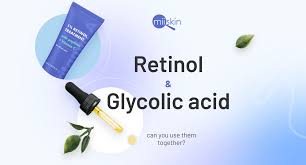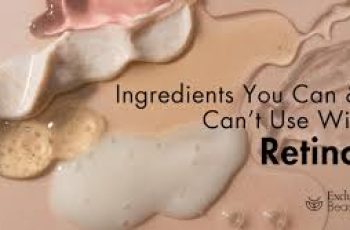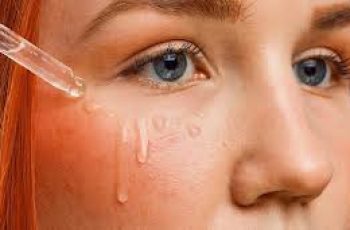
Can You Use Retinol After Glycolic Acid? Here’s What You Need to Know
Glycolic acid and retinol are two of the most powerful ingredients in modern skincare. They’re known for transforming dull, uneven skin into a smoother, clearer, and younger-looking complexion.
Both are often featured in top-selling skincare products. But that raises a key question: Can you safely use retinol after glycolic acid?
These two ingredients each have impressive benefits, but because they’re both active and potent, using them together requires some know-how.
Today, we’ll break it all down and help you make the most of your skincare routine.
What Is Glycolic Acid?
Glycolic acid is an alpha hydroxy acid (AHA). It’s water-soluble and derived from sugarcane. Among all AHAs, glycolic acid has the smallest molecular size, so it penetrates the skin effectively.
Its primary role in skincare is exfoliation. It loosens the bonds between dead skin cells, making it easier for them to shed and reveal new, glowing skin underneath.
Using glycolic acid regularly can:
Brighten dull skin, Minimize fine lines and wrinkles, Fade hyperpigmentation, Smooth out rough skin texture, Clear clogged pores
It’s commonly found in toners, cleansers, pads, serums, and masks.
What Is Retinol?
Retinol is a derivative of vitamin A and part of the retinoid family. It’s known for increasing the skin cell turnover rate and stimulating collagen production.
It helps:
Reduce fine lines and wrinkles, Treat acne and congestion, Improve skin firmness, Even out pigmentation and dark spots, Smooth out uneven texture
Retinol is often found in serums, night creams, and prescription-strength formulas (like tretinoin or Retin-A).
Can You Use Retinol After Glycolic Acid?
Technically, yes—but only under the right circumstances. Both ingredients are effective, but also potentially irritating. Using them back-to-back or layering them without caution can lead to sensitivity.
This includes redness, dryness, peeling, and an impaired skin barrier.
Here’s the general rule:
You can use glycolic acid and retinol in the same routine—but not at the same time. For most people, it’s best to separate their usage between morning and evening, or alternate them on different nights.
What Should You Use After Glycolic Acid?
After using glycolic acid, your skin is in a freshly exfoliated state. This is when it’s best to follow with hydrating and barrier-strengthening ingredients.
Some great options include:
Hyaluronic acid – attracts and retains moisture
Niacinamide – soothes skin and supports barrier repair
Ceramides – rebuild the skin’s lipid layer
Peptides – support collagen and skin recovery
Avoid harsh or drying ingredients immediately after using glycolic acid. Let your skin recover with hydration and moisture.
What Should You Not Mix With Glycolic Acid?
Some ingredients don’t play well with glycolic acid and may cause irritation when layered or used too closely. Avoid combining glycolic acid with:
Salicylic acid – too many exfoliants can cause dryness or peeling
Vitamin C (L-ascorbic acid) – unstable and can irritate when paired
Benzoyl peroxide – overly drying in combination
Strong retinoids (like tretinoin) – may over-exfoliate the skin
If you want to use multiple actives, apply them on alternate nights or at different times of day to give your skin time to rest.
Can You Use Glycolic Acid With Retinol and Niacinamide?
Yes—but how you layer them matters. Here’s a safe way to use all three:
AM:
Cleanse, Glycolic acid toner or serum, Niacinamide serum, Moisturizer, SPF 30+
PM:
Cleanse, Niacinamide (if tolerated), Retinol, Moisturizer
This routine helps minimize irritation while allowing each ingredient to deliver results.
Always do a patch test before trying new combinations, especially if you have sensitive skin.
Can You Use Glycolic Acid in the Morning and Retinol at Night?
Yes, and this is one of the safest ways to use both in the same day.
Morning: Apply glycolic acid (cleanser, toner, or serum) followed by a hydrating serum, moisturizer, and sunscreen.
Night: Use retinol after cleansing, followed by a calming, non-active moisturizer.
By spacing them out, you reduce the risk of over-exfoliation and allow each ingredient to perform without interference.
Why Can’t You Use Retinol and Glycolic Acid Together?
You technically can, but layering them in the same routine increases your chances of irritation. Both ingredients:
Exfoliate the skin (retinol indirectly, glycolic directly)
Can cause dryness, peeling, or stinging
Weaken the skin barrier if overused
Using both without giving your skin time to adjust can lead to inflammation, especially for those with sensitive or dry skin types.
How Often Should You Use Glycolic Acid?
If your skin tolerates it, glycolic acid can be used daily. People with oily or acne-prone skin often benefit most from daily use.
For dry or sensitive skin types, start with 2–3 times a week and monitor how your skin responds. If irritation occurs, scale back.
Gentler AHAs like lactic acid or PHAs may be better suited to delicate skin.
How Should You Layer Glycolic Acid and Retinol Safely?
If you’re determined to use both ingredients in your routine, here’s a gentle schedule to follow:
Option 1: Alternate Nights
Monday, Wednesday, Friday: Glycolic acid
Tuesday, Thursday, Saturday: Retinol
Sunday: Hydration and recovery only
Option 2: AM/PM Split
Morning: Glycolic acid toner or cleanser
Evening: Retinol serum or cream
Be sure to hydrate well and use SPF daily when following either method.
When Should I Use Glycolic Acid In My Routine?
That depends on the product type:
Cleanser: Use as your first step in the routine
Toner or pad: Apply after cleansing
Serum: Apply after toner, before moisturizer
Moisturizer or mask: Use as your last step or weekly treatment
Always apply products from thinnest to thickest consistency. This helps ensure proper absorption and avoids disrupting your routine.
How Do I Know If I’m Overdoing It?
Signs you’re overusing glycolic acid and/or retinol include:
Redness or inflammation, Dry patches or flaking, Increased sensitivity, Stinging or burning, New breakouts or irritation
If this happens, stop active treatments and focus on hydrating and repairing products. Once your skin returns to normal, ease back in slowly.
Tips for Using Glycolic Acid and Retinol Together
Always apply sunscreen every morning—these ingredients make skin more sun-sensitive.
Keep your skin moisturized with hydrating serums and emollient creams.
Start slowly with either ingredient before combining.
Never layer them directly unless a product is specifically formulated with both.
Introduce niacinamide to soothe and balance the skin barrier.
Consult a dermatologist if you have sensitive, acne-prone, or rosacea-prone skin.
So, Can You Use Retinol After Glycolic Acid?
Yes, but do so cautiously. They can be part of the same skincare routine, but not at the same time—unless your skin is experienced and resilient.
The safest approach? Use glycolic acid in the morning and retinol at night—or alternate them on different days. Always follow with hydration, and don’t skip your sunscreen.
If you’re still unsure how to fit these ingredients into your routine, drop us a message on Instagram—we’d love to help you find the perfect balance for your skin. See you in the DMs!


